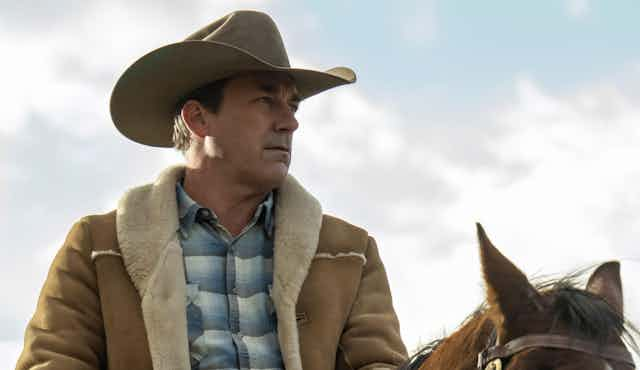Warning: includes spoilers for the first eight episodes of Fargo season five.
The latest series of Fargo includes a two-minute tracking shot that focuses on the menacing face of the sheriff, ranch owner, evangelical Christian and Donald Trump supporter Roy Tillman (Jon Hamm). He is filmed in tight close-up as he stomps through the snow to a small barn that houses his chained former wife, the show’s heroine Dot Lyon (Juno Temple).
The scene is accompanied by Lisa Hannigan’s slow and haunting cover of Britney Spear’s hit song Toxic, which was rearranged specifically for the series by composer Jeff Russo.
It makes for tense and difficult viewing. The audience have witnessed Tillman’s casual violence towards women throughout the series. He has just been humiliated in a political debate, and is clearly hellbent on redeeming his tarnished masculine self-image by doubling down on the recaptured young wife who had the temerity to escape his clutches.
As this brief plot outline suggests, domestic violence is at the heart of Fargo’s fifth season and each episode ends with a list of domestic abuse hotlines.
The priority given to this theme has, however, provoked some negative responses. Forbes critic Erik Kain argues, for example, that by tackling a serious social issue, Fargo has undermined its trademark humour and become too earnest. The series – set in America’s Midwest in 2019 – has generally been hailed as a triumphant “return to form”, though, following the less well-received series three and four. Season four marked a departure from the show’s contemporary setting, taking place during the 1950s.
As a feminist academic who has been writing on representations of domestic abuse since the noughties, it has been gratifying to see the substantial increase in fictional depictions of this theme in the 21st century. I believe the success of the new Fargo series lies in the creators’ bold decision to draw direct connections between the “private” crime of domestic violence and today’s public culture of masculinity that is linked to misogyny.
Domestic violence on screen
Despite the much higher awareness of domestic violence that emerged from the second-wave feminist movement, mainstream films that offered a sympathetic view of abused women were rare in the late 20th century.
Furthermore, they tended to rely on the casting of established female stars with a “girl next door” image to draw identification to the still-marginalised figure of the “battered wife”, such as Farrah Fawcett in The Burning Bed (1984) and Julia Roberts in Sleeping With the Enemy (1991).
This has shifted in the 21st century, with feminist issues once more, though in a different way, having a higher profile in mainstream culture due to global campaigns. This includes #MeToo, when women across the world reposted the hashtag indicating their status as survivors of sexual abuse.
Hollywood films such as Waitress (2007), The Girl on the Train (2016), The Invisible Man (2020) and TV dramas such as Angela Black (2021), Big Little Lies (2017) and Maid (2021) have featured extended domestic violence plot lines. Long-running soap operas such as Eastenders and even cosy radio soap The Archer, have also covered the topic.
However, as I argued in my recent research, many of these dramas present male violence towards women as a rare phenomenon, perpetuated by a few “bad apples” whose behaviour has little relation to mainstream masculine attitudes.
Sadly, all available evidence suggests that domestic abuse is far from abnormal. According to the World Health Organization, one in three women globally have experienced it. It is somewhat less common in higher-income regions with greater levels of gender equality (such as Europe and the US), but the percentage of women who have experienced domestic abuse in these areas is still 20%.

A cultural problem
Despite its darkly comedic tone, the new series of Fargo accurately presents the abuse of women as a cultural rather than individual problem by highlighting its presence in politics, religion and the law.
Its depiction of sheriff and wife-beater Tillman (promoted in his election campaign as “a hard man for hard times”) challenges traditional American fantasies of rugged but benign masculine power.
Tillman is shown watching a televised Trump rally, then slapping his wife immediately afterwards. He draws on the authority of the church when instructing other men on how to punish their wives. To accentuate the endemic nature of gendered abuse, the other key female character, policewoman Indira Olmstead (Richa Moorjani), is subjected to financial abuse by a lazy, cheating husband who criticises her wifely skills.
Given Fargo’s depressing but perceptive view of endemic patriarchal abuse, it is not surprising that the all-female place of safety and recovery where heroine Lyon seeks shelter before her recapture by Tillman is called “Camp Utopia” – and turns out to be a dream.

Looking for something good? Cut through the noise with a carefully curated selection of the latest releases, live events and exhibitions, straight to your inbox every fortnight, on Fridays. Sign up here.

